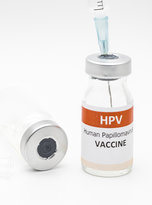Read and report vaccine reactions, harassment and failures.
Human Papillomavirus (HPV) Disease and Vaccine Information

HPV: The Disease
Human papillomavirus (HPV) is the most commonly sexually transmitted infection in the U.S. There are more than 200 known types of HPV and about 75 percent of these types are considered not harmful. The most common high-risk cancer-causing HPV types are 16 and 18. There are six HPV-related cancers; cervical, oral (oropharyngeal), vaginal, penile, anal, and vulvar.
Most sexually active women and men become infected with HPV, with the majority of cases recovering from infection without symptoms or complications and more than 90 percent of cases recover within two years. Natural recovery provides HPV type specific antibodies within the individual’s body to help prevent future infections; however, the protection may not be life-long.
The American Cancer Society estimates in 2023 that out of an estimated total U.S. population of 334 million individuals a total of just over 30,000 (.009 percent) HPV-related cancer cases will occur and result in under 8,000 (.002 percent) deaths for HPV types targeted by Gardasil 9 vaccine. Learn more about HPV…
HPV Vaccine
While there are three FDA licensed HPV vaccines, only Gardasil 9 by Merck is currently available in the U.S. The CDC’s current recommendation is a two-dose series for ages 15 through 26 years, and those with immunocompromising conditions. Gardasil 9 by Merck was licensed to prevent HPV-related cervical, vulvar and anal cancers, genital warts, and precancerous lesions. According to the CDC, the effectiveness of HPV vaccination is still unknown and it may take decades to see population-level impact
from HPV vaccine.
Though public health officials acknowledge there is minimal benefit in adult HPV vaccination, the vaccine is available to adults 26 through 45 years. For females over 21 years of age, HPV vaccination does not replace the need for routine Pap smear testing to detect abnormal cells that can cause cervical cancer especially considering that cervical cancer can be caused by HPV types not included in the vaccine. Learn more about HPV vaccine…
HPV Quick Facts
HPV
- Chronic infections are rare and occur mostly in women. Sometimes HPV infection does not clear from the body naturally and the infection becomes chronic. High risk factors for developing HPV-related cancers include: smoking, multiple sexual partners, long-term oral contraceptive use, multiple births, weakened immune system, co-infection with chlamydia or HIV, poor nutrition, heavy drinking and smoking, and chronic inflammation;
- After Pap smear tests that screen for cancerous conditions became a routine part of gynecological health care for American women in the 1960’s, U.S. cervical cancer cases dropped by 75 percent. Women are recommended to get regular Pap tests throughout their life whether or not they get HPV vaccinations; Continue reading quick facts…
HPV Vaccine
- Licensed in 2006 for 11-12 year old girls and young women, thousands of adverse reaction reports related to Gardasil were filed for: sudden collapse with unconsciousness within 24 hours, seizures, muscle pain and weakness, disabling fatigue, Guillain Barre Syndrome (GBS), facial paralysis brain inflammation, rheumatoid arthritis, lupus, blood clots, premature ovarian failure, optic neuritis, multiple sclerosis, strokes, heart and other serious health problems, including death were reported. Similar reports have been filed for the Gardasil 9 vaccine licensed in 2014 for use by females and males ages 9 to 45 years, even though the recommended number of doses was reduced from three to two.
- Using the MedAlerts search engine, as of March 29, 2024, the federal Vaccine Adverse Events Reporting System (VAERS) contains 76,187 reports of HPV vaccine reactions, hospitalizations, injuries and deaths and, includes 633 related deaths, 7,705 hospitalizations, and 3,741 disabling conditions. Over 55 percent of the reported serious adverse events occurred in children and teens under 17 years of age. Continue reading quick facts…
NVIC encourages you to become fully informed about HPV and the HPV vaccine by reading all sections in the Table of Contents below, which contain many links and resources such as the manufacturer product information inserts, and to speak with one or more trusted health care professionals before making a vaccination decision for yourself or your child. This information is for educational purposes only and is not intended as medical advice.



